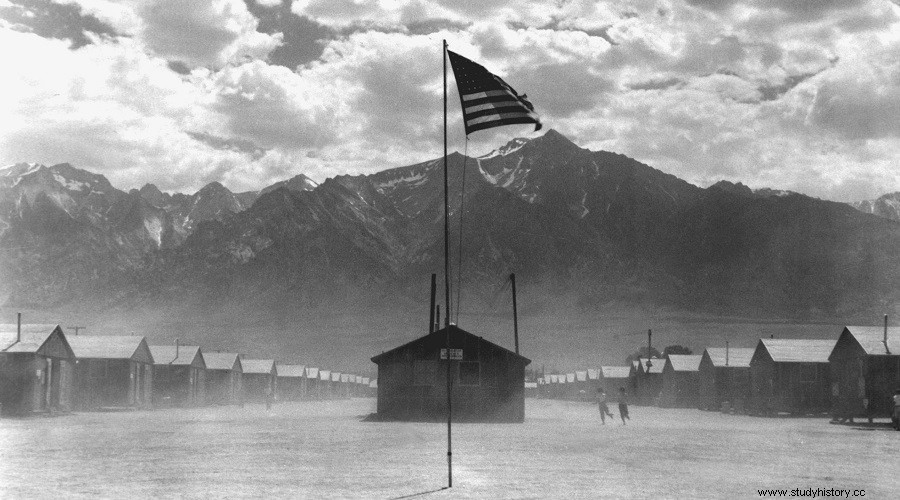
The Japanese community in the United States has suffered strong prejudice against from the beginning of the 20th century. The Japanese attack against the US and the participation of the Americans in World War II, combined with strong hysteria, led to a persecution of this community, which was installed in concentration camps monitored by the US army.
These concentration camps are called internment camps in the United States. , which in Portuguese means “internment camps”. This term is criticized by historians who consider its use as a resource to mitigate the impact of camps and a way to avoid the use of concentration camps , which means “concentration camps” in Portuguese.
Prejudice against the Japanese community in the US
North American society received a large number of immigrants who, at the turn of the 19th to the 20th century, saw the American continent as a chance to seek better living conditions. One of the major groups to migrate to the United States in this context were the Japanese. How Japan faced radical changes since the Meiji Restoration , the United States was seen as a favorable place for immigration.
The Japanese who migrated to the United States at that time focused on Hawaii and on the West Coast because of the geographic proximity and worked in several areas, mainly in farms and in construction works of the railroads. The Japanese community grew rapidly, and by the 1920s, 111,010 Japanese and Japanese descendants lived in the United States|1 |.
The growth of this community in the United States led to the emergence of strong prejudice, located mainly on the West Coast, especially the State of California. Community groups emerged demanding laws to implement discriminatory measures (which in fact ended up happening). The result of this was the ban on the entry of new eastern immigrants into the United States from 1924 onwards.
Attack on Pearl Harbor and life in the concentration camps
During the 1920s and 1930s, the relationship between the United States and Japan suffered great strain. This resulted in the Japanese attack on the US naval base at Pearl Harbor in Hawaii on December 7, 1941. The US declaration of war on Japan took place the next day. With the conflict between these two nations, the Japanese community began to suffer intense persecution within the United States.
The descendants of Japanese, or Japanese-Americans, came to be seen in a stereotypical way and suffered the consequences of unfounded rumors and accusations of collaborationism. The Japanese-American community was accused of spying and preparing to support the Japanese army's invasion of the West Coast. The rumors were unfounded, and American intelligence knew thatthere was no any kind of collaborationism present in the Japanese community.
However, because of popular pressure caused by war hysteria, the US government, by order of President Franklin Delano Roosevelt , decreed the Executive Order 9066 on February 19, 1942, allowing the army to imprison citizens who posed a risk to the war effort.
This started a process that resulted in the imprisonment of an estimated 120,000 Japanese Americans. All those with at least 1/16 of Japanese ancestry were evacuated. These Japanese-Americans were forced to quit their jobs and sell their belongings (houses, cars, etc.). In addition, all personal belongings were searched by the FBI, the US Federal Bureau of Investigation.
Initially, these people were placed in temporary camps, while concentration camps were being built. A total of ten fields were built in different American states. The authority of the camps was handed over to a government department called War Relocation Authority (WRA), which translated means “War Relocation Authority”.
Japanese Americans' life in the countryside was hard, as the lodges were not designed to withstand the climatic variations of some American regions. In addition, there was little privacy, little medical care and almost no structure to make their lives more comfortable.
The camps were built in isolated locations and were heavily monitored, with barbed wire fences, tall monitoring towers and heavily armed security. In addition, the WRA used anthropologists to learn how to manipulate inmates and keep them under control so that riots could be avoided.
Reconstruction
With the end of the war, the WRA's authority over the camps lost its validity, and the last camp was officially closed in early 1946. Japanese Americans had little or in many cases no assistance government to rebuild their lives and most ex-prisoners were never able to regain the same standard of living as before the war.
Throughout the 1950s, a number of community groups fought to defend the rights of the Japanese community in the United States, which resulted in a formal apology given by the government. American during Ronald Reagan's presidency in 1988. In addition, each surviving prisoner was compensated with approximately $20,000 for his time in the camps.
|1| VAN SANT, John E. Pacific Pioneers:Japanese Journeys to America and Hawaii, 1850-80. Urbana:University of Illinois Press, 2000, p. 3.
